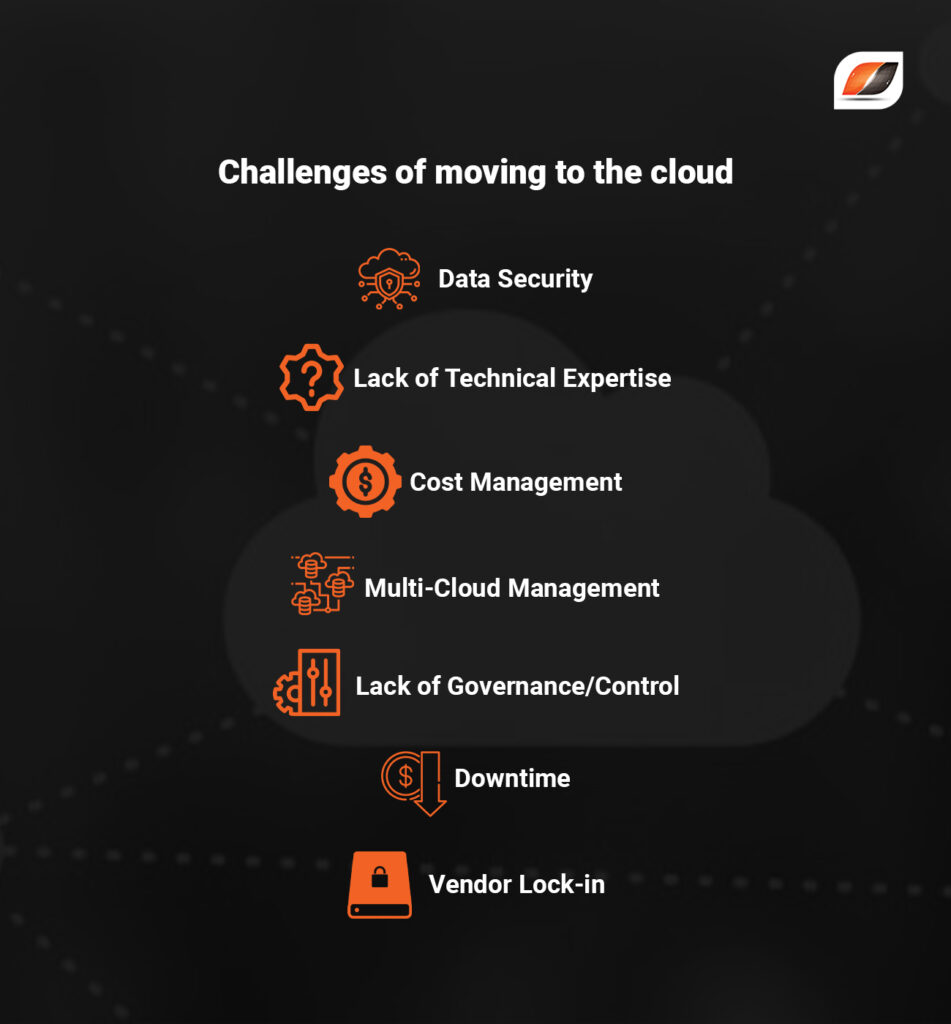In 2020, the end-user spending on cloud services totalled $270 billion and it is expected to grow by 23.1 % in 2021. (Source) Businesses are embracing software technology and accepting it with open arms. However, they face specific challenges and problems that tag along with the technology. In this blog, we share the top 7 challenges your business can face while moving to cloud.
Challenges of moving to cloud
Data security
Security of business data is the biggest concern for businesses when moving to the cloud. After all, they are storing their sensitive information on a remote server. According to the 2020 cloud security report, 75% of respondents are ‘very concerned’ or ‘extremely concerned’ about public cloud security. Hence, the constant question is, does the cloud service provider ensure a robust network, firewalls, etc., to protect the data?
Further, the constant headlines of data breaches, hacked interfaces, broken authentication, etc., elevate the issue. So, as you move your business to the cloud, make sure to ask your vendor important questions like-
- How do they protect data from being corrupted?
- What measures do they take to protect individual’s data?
- What is their backup plan if something goes wrong?
Lack of technical expertise
The cloud domain is evolving rapidly, and new technologies are coming day in, day out. As advancements make their way into the market, businesses have to upgrade their resources and expertise to keep up with them.
This means additional training for existing employees and hiring new employees with advanced skillsets. As a business, you may also have to regularly assess the available resources and make ways to acquire the upgraded ones.
Lack of technical expertise can hinder your cloud movement and stop your business from effectively utilising the power of the cloud.
Cost management
Major cloud service providers have a monthly subscription or pay-per-use plans. They do not include any upfront cost, and you can conveniently scale the services. Although this ideal for most businesses, a business with unstable cash flow can find this challenging. For such companies, the ideal option is to pay the total cost in one go and utilise the services for a longer duration.
Also, businesses sometimes find it hard to track and estimate their costs because they can vary every month. Thus, it gets tricky for the finance team to allocate the appropriate cost and make monthly budgets.
Multi-cloud management
According to the Flexera 2021 state of the cloud report, 92% of businesses have a multi-cloud strategy in place. This suggests that companies are blending multiple cloud services in their business operations. Although this allows them to leverage the strengths of various clouds, it is tough to manage the technology efficiently.
Businesses have to invest numerous resources in training the staff, rethinking procedures, tooling, etc., to leverage a multi-cloud environment.
Lack of Control/ Governance
In the evolving cloud era, proper IT governance/ control will ensure the softwares and services are implemented as agreed upon in the policies. Alongside, it will also ensure that the assets are optimally controlled and maintained.
Currently, IT does not have complete control over the provisioning, operations and infrastructure in the cloud space. Thus, they have not been able to provide the required compliance, governance, risk management and data quality to businesses.
Downtime
In a world that’s always up, your business can suffer substantial losses if they experience downtime. And as you move the cloud, the control to take action lies in the hands of the cloud service provider. So, if downtime occurs, all you can do is wait for the service operator to take necessary actions and resolve the issue.
Moreover, since the data is stored on the cloud, most businesses can only access it with a robust internet connection. So a poor connection can disrupt the services and increase accessibility risk.
While it is hard to mitigate all the risks, taking up the services of a top cloud provider and having a disaster recovery system in place can help your business.
Vendor lock-in
Vendor lock-in can occur when you’re trying to move your data from one cloud service to another. Likewise, you can encounter application lock-in when you are trying to move a cloud-native application. Reconfiguring it on another cloud domain is a cumbersome and time-consuming task.
Alongside, you can encounter data lock-in while extracting and transferring crucial business information from one cloud server to another. You can avoid vendor lock-in by working with specialist application vendors and building a cloud environment keeping the best practices in mind.
Solution: moving to cloud with 365Solutions
We understand that moving to the cloud can be daunting for a business. However, the advantages outweigh these challenges. Also, at 365Solutions, we follow a strategic approach to help enterprises swiftly move their business to the cloud. Our IT experts are available 24*7 provide a seamless migrating experience. So without any delay, start your cloud journey with us. For more information, visit our website or write to us at sales@365solutions.com.




